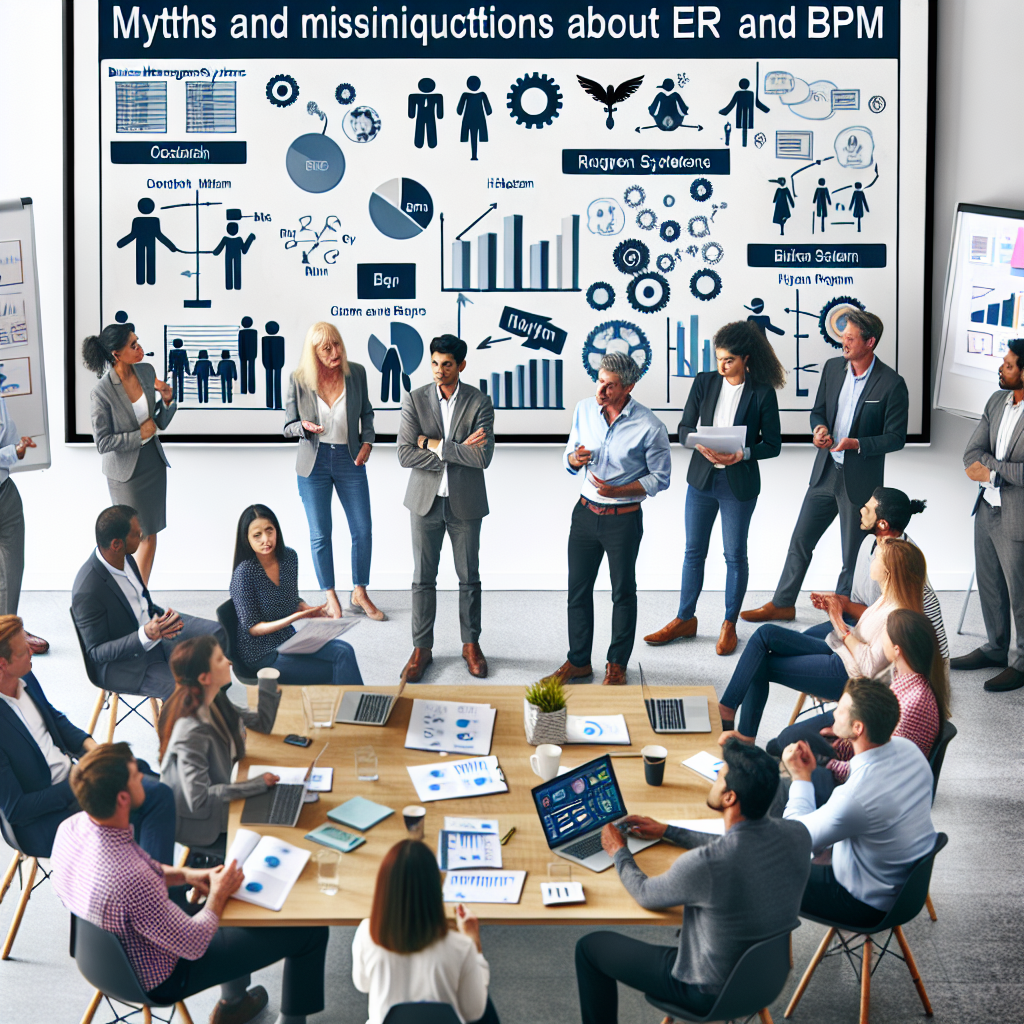
When it comes to streamlining operations and boosting productivity, two terms often pop up: ERP and BPM. Many people wonder, "What is the difference between ERP and BPM?" If you find yourself in that camp, youre not alone. Let’s break it down in simple terms.
ERP (Enterprise Resource Planning) focuses on integrating all facets of a business—like finance, HR, and supply chain—into one system. Imagine it as a comprehensive toolbox that allows various departments to share and access data seamlessly. For instance, a retail business can see real-time stock levels and instantly manage orders from customers without juggling multiple spreadsheets. ⭐
BPM (Business Process Management), on the other hand, is more about optimizing workflows and processes. It’s like a GPS for your business! By mapping out every specific task and improving it, BPM ensures each route is the fastest and most efficient, helping you save time and money. For example, a manufacturing company might use BPM to smooth out its production line, ensuring that every step, from raw material to finished product, is as effective as possible. ⭐
| Feature | ERP | BPM |
| Focus | Integration of departments | Optimization of processes |
| Scope | Broad enterprise functions | Specific tasks & workflows |
| Goal | Streamlined information & resources | Increased efficiency & effectiveness |
| Flexibility | Less adaptable to changes | Highly adjustable to business needs |
| Implementation Costs | Higher initial costs | Cost-effective in long term |
| User Base | Entire organization | Specific teams & individuals |
| Data Handling | Centralized data | Real-time process feedback |
| Use Case | Finances, HR, Supply Chain | Processes in manufacturing, service delivery |
| Example Tools | SAP, Oracle | Bizagi, Appian |
Now that weve peeled back the layers, let’s look at some real-life scenarios.
Take John, a small business owner. He struggled with managing his sales data across different platforms, leading to missed opportunities. Once he integrated an ERP system, his team was able to access and utilize customer data effectively, boosting sales by 30% in just three months. ⭐
On the other hand, we had Rebecca from a manufacturing plant. Her team was experiencing serious delays because of inefficient processes on the floor. By implementing a BPM solution, they re-engineered their workflow, which cut production time by 25% and saved thousands in operational costs! ⭐
As we look ahead to business process automation in 2025, integrating both ERP and BPM will be crucial. It’s essential to regularly evaluate your softwares performance. Updating your systems at least once a year can prevent potential hiccups down the road.
Additionally, ensuring seamless integration between ERP and BPM tools maximizes data utility across departments. For example, aligning real-time data from your ERP can greatly enhance the BPM workflows, allowing for quicker decision-making based on current business needs. ⭐
We’re not just another IT company! With over 20 years of experience, our professional specialists offer every service in one place, from development to ongoing support. You wont have to juggle multiple vendors. Just reach out to us at +373 601 066 66 or visit our website at webmaster.md to learn how we can transform your business operations today. We guarantee satisfaction with our services. ☑️

As we approach 2025, the landscape of Business Process Automation (BPA) is set to revolutionize the way we think about ERP (Enterprise Resource Planning) and BPM (Business Process Management). But how exactly will this transformation unfold? Let’s dive into the exciting advancements on the horizon! ⭐
Imagine a future where repetitive tasks are handled effortlessly, leaving your team to focus on strategic initiatives and creative problem-solving. This is the promise of BPA. By integrating BPA with both ERP and BPM systems, businesses will experience unprecedented efficiencies. For instance, consider a manufacturing company currently bogged down by manual data entry and approvals. With BPA, workflows can be automated, reducing human error and increasing speed. ⭐
In 2025, we can expect ERP and BPM systems powered by advanced data analytics. This means not just collecting data but interpreting it in real-time. Businesses will harness large volumes of data and convert them into actionable insights automatically. According to a recent study, companies leveraging advanced analytics saw a 30% improvement in operational efficiency. Imagine what that could do for your bottom line! ⭐
The integration of AI and machine learning into ERP and BPM systems will bring intelligent automation to the forefront. These advanced technologies will analyze past interactions and predict future outcomes, making systems more responsive to your business needs. For example, a retail business can optimize inventory management by anticipating seasonal demand fluctuations, resulting in reduced costs and enhanced customer satisfaction. This could lead to a potential profit boost of up to 25%! ⭐
Another area of transformation will be in communication. Automated systems will facilitate seamless collaboration within teams. Chatbots and AI assistants will handle routine queries and updates, freeing employees to work on more critical tasks. Additionally, real-time notifications will keep everyone aligned, ensuring that no task slips through the cracks. Imagine having your daily updates and task reminders automated – that’s the future were heading towards! ⭐
Companies are already paving the way for this transformation. For instance, a leading logistics firm automated their shipment tracking process through BPA, significantly reducing shipping errors and enhancing customer satisfaction rates by 40%. Similarly, a global tech company leveraged BPA to streamline customer service inquiries, resulting in a 50% reduction in response times and improved client retention. These examples are just the beginning! ⭐
As we gear up for these changes, businesses must start laying the groundwork today. Here are some actionable steps you can take to prepare:
In 2025, the combination of BPA with ERP and BPM will not only streamline your business processes but also provide insights that could drastically change how your company operates. Early adopters who embrace these technologies will not only stay competitive but likely leap ahead. Don’t wait for the future to arrive—start planning your automation journey today!
Ready to embrace the future? Contact us today at +373 601 066 66 or visit webmaster.md to learn how our expert team can guide you in transforming your business through automation!

When it comes to ERP (Enterprise Resource Planning) and BPM (Business Process Management), there are a lot of misconceptions floating around that can cloud your judgment. These myths can prevent businesses from investing in these essential systems, leading them to miss out on significant advantages. Let’s debunk some of the most common myths to help you make informed decisions! ⭐
This is perhaps the most pervasive myth. Many small and medium businesses believe that only large corporations can benefit from ERP or BPM systems. In reality, these tools can cater to businesses of any size. For example, a small manufacturing company can use ERP to manage inventory efficiently and streamline operations, while a mid-sized service provider can leverage BPM to optimize workflows. Ultimately, implementing these systems can lead to substantial savings and improved performance, regardless of company size. ⭐
Another common misconception is that the implementation of ERP and BPM systems takes forever and requires excessive resources. While it can feel overwhelming without a structured approach, modern solutions are designed with user-friendly interfaces and streamlined setup processes. Many companies, like a local retail store, have successfully implemented ERP within a few months, minimizing downtime and ensuring a smooth transition. The key lies in selecting the right partner to guide you through the implementation journey. ⭐️
Some folks confuse ERP and BPM, thinking they are interchangeable terms. Though related, they serve different purposes. The ERP system integrates various business functions such as finance, supply chain, and HR into a single platform, while BPM focuses on optimizing and automating workflows within those functions. Think of ERP as the backbone of your operations while BPM is the engine that drives efficiency. Understanding this distinction can help businesses select the right tools for their specific needs. ⚙️
Many businesses tend to ignore ERP and BPM systems until a crisis arises, thinking, “If it’s not broken, don’t fix it.” However, waiting for problems to prompt a change can put businesses at risk. By proactively adopting these systems, you can enhance productivity, streamline processes, and stay ahead of competitors. For instance, a healthcare provider that implements a BPM system can address patient tracking issues before they lead to service delays, ensuring a smooth experience for patients. ⭐
If you’ve heard that ERP and BPM solutions are generic and will fit any organization, think again. Every business is unique, and these systems can be customized to align with your specific processes, needs, and objectives. A financial services firm may require integrations for compliance tracking, while a manufacturing plant may need real-time inventory tracking features. Working with a tailored solution ensures that you maximize the benefits of your investment. ⭐️
Lastly, many organizations believe that implementing an ERP or BPM system is a one-time job. The truth is, these systems require ongoing support, updates, and optimization to remain effective. Regular assessments can help you identify areas for improvement and leverage new features as they become available. For example, organizations in the tech space are constantly updating their systems to keep pace with industry changes. Your organization must evolve too! ⭐
By debunking these common myths, businesses can make more informed decisions about adopting ERP and BPM systems. Understanding their true value can lead to improved efficiency, enhanced data management, and smarter processes—all of which contribute to sustainable growth. In today’s fast-paced world, this kind of agility is essential for staying competitive. ⭐
If you’re considering implementing ERP or BPM solutions but were held back by these misconceptions, now is the time to take action. Our expert team, with 20 years of experience in providing tailored solutions, can help you navigate the process smoothly. Contact us at +373 601 066 66 or visit webmaster.md to explore how you can leverage these powerful systems for your business success!

In today’s fast-paced business landscape, understanding the differences between ERP (Enterprise Resource Planning) and BPM (Business Process Management) is essential for future-proofing your business strategy. This knowledge not only empowers your decision-making but also sets the stage for sustainable growth and success in an ever-evolving market. So why does this matter? Let’s dig in! ⭐
ERP serves as the backbone of many organizations, integrating key functions like finance, HR, supply chain, and customer relations into one cohesive system. Imagine you are managing an e-commerce business. Having a robust ERP can help you keep track of inventory levels, process orders, manage financial data, and improve customer relationship management—all from one platform. This integration leads to streamlined operations and data-driven decision-making. ⭐
A recent study stated that companies using ERP systems report a 22% increase in productivity. This statistic emphasizes ERPs capabilities in enhancing performance, making it a critical element of a solid business strategy.
Conversely, BPM focuses on optimizing and automating business processes. For businesses looking to increase efficiency, minimize waste, and improve quality, BPM is a game changer. Think about a healthcare organization that needs to manage patient data flows efficiently—implementing BPM can help streamline processes like appointment scheduling, billing, and patient follow-ups, resulting in enhanced patient experiences. ⭐
Organizations with effective BPM solutions are reportedly 48% more likely to have increased customer satisfaction. This showcases how adaptability and process optimization can play a pivotal role in your long-term strategy.
Understanding the interplay between ERP and BPM systems is crucial for creating a comprehensive strategy. Here’s why:
As we look ahead, businesses will face challenges ranging from technological advancements to changing consumer expectations. By understanding the differences—and the strengths—of ERP and BPM, organizations can proactively adapt to these changes. For example, with the rise of remote work, having robust collaborative tools integrated with your systems can set the stage for continued productivity and engagement. ⭐
If your organization has yet to explore the opportunities presented by ERP and BPM, now is the perfect time to start! At SEO-in.md, we have over 20 years of experience helping businesses develop strategies tailored to their unique needs. Our team of expert specialists offers comprehensive support—from initial assessments to implementation. Reach out to us at +373 601 066 66 or visit webmaster.md to discover how we can help you secure your future. ⭐
Leaders in the IT market |
| 14+ years of experience and innovative solutions to help your business stand out and grow. |
Inspiring portfolio |
| 150+ successful projects: from sleek landing pages to complex corporate systems. |
Team of experts |
| 51+ professionals who bring your ideas to life with maximum efficiency. |

| NOTORIUM TRADEMARK AWARDS |
| Notorium Trophy 2017, Notorium Gold Medal 2018, Notorium Gold Medal 2019 |

| TRADE MARK OF THE YEAR |
| Gold Medal 2016, Gold Medal 2017, Gold Medal 2018, Gold Medal 2019 |

| THE BEST EMPLOYER OF THE YEAR |
| According to the annual Survey conducted by AXA Management Consulting - 2017, 2018, 2019 |